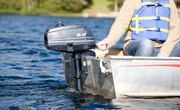Even in the dead of winter, a dedicated boater tinkers with the boat. One form of tinkering, adjusting the idle speed of your 48-horsepower Evinrude outboard motor, is a step closer to the best time of the year. You can spend time with the boat, performing a maintenance task that would otherwise delay the start of of that magical time boaters call "boating season." A straightforward process, it comes with a warning from the manufacturer.
Items you will need
Small adjustable wrench
Screwdriver
Attach the alligator clip of a shop tachometer to your motor's spark plug. Connect a garden hose to your motor by attaching the hose to a flushing attachment and then placing the flushing attachment over the motor's cooling water intake ports.
Turn the water on full force. Start the engine and allow it to rise to its usual operating temperature.
Operate the engine at idle with the shifter in the "Forward" gear position. Note the engine speed shown on the shop tachometer; the engine should idle between 725 rpm and 775 rpm. The ideal idle is somewhere near the midpoint of this range, about 750 rpm.
Loosen the lock nut on the idle speed adjustment screw with a small adjustable wrench. Turn the screw clockwise with a screwdriver to increase the idle speed; turning the screw counterclockwise decreases the idle speed. Recheck the idle speed indicated on the shop tachometer with the shifter in "Forward" and make further adjustments, if needed.
Tips
- Evinrude advises that you stop the motor before making adjustments. After making the initial adjustment, restart the motor, check the shop tachometer, stop the motor and make further adjustments in the hope of eventually hitting the right position for the idle speed screw. If you choose to disregard this advice, use extreme caution around the moving parts of the motor.
References
- "Evinrude Repair Manual -- 2.5 to 250 HP Models, 2002-2007"; Seloc Marine; 2007
Tips
- Evinrude advises that you stop the motor before making adjustments. After making the initial adjustment, restart the motor, check the shop tachometer, stop the motor and make further adjustments in the hope of eventually hitting the right position for the idle speed screw. If you choose to disregard this advice, use extreme caution around the moving parts of the motor.
Writer Bio
Will Charpentier is a writer who specializes in boating and maritime subjects. A retired ship captain, Charpentier holds a doctorate in applied ocean science and engineering. He is also a certified marine technician and the author of a popular text on writing local history.



